Personal and Professional Development Plan Report - PPD Plan
VerifiedAdded on 2023/01/06
|20
|4519
|84
Report
AI Summary
This report provides a comprehensive overview of personal and professional development (PPD), outlining the PPD planning process, skill audits, and SWOT analysis. It delves into the application of the PPD planning process, including establishing purpose, identifying development needs, formulating action plans, and recording outcomes. The report also explores the VARK and Belbin theories, analyzing learning styles and team roles, respectively. Furthermore, it reflects on the challenges that arise from PPD plans, highlighting the importance of skill audits and SWOT analysis in identifying strengths, weaknesses, opportunities, and threats. Finally, the report includes a reflection on transferable skills developed during the course, emphasizing the importance of continuous professional personal development (CPPD) for career advancement. Appendices include the PPD plan, VARK and Belbin questionnaire results, and CPPD details.
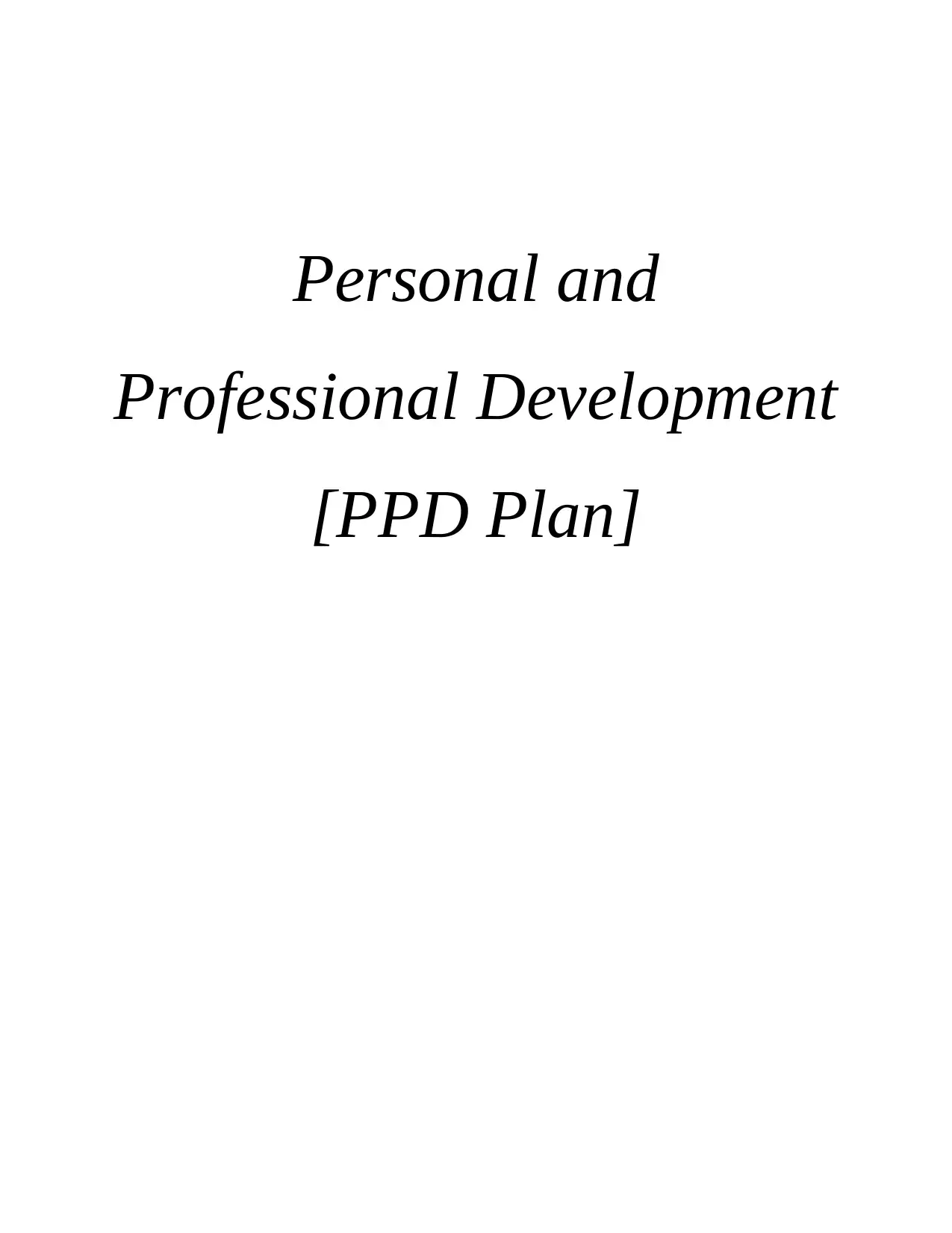
Personal and
Professional Development
[PPD Plan]
Professional Development
[PPD Plan]
Paraphrase This Document
Need a fresh take? Get an instant paraphrase of this document with our AI Paraphraser
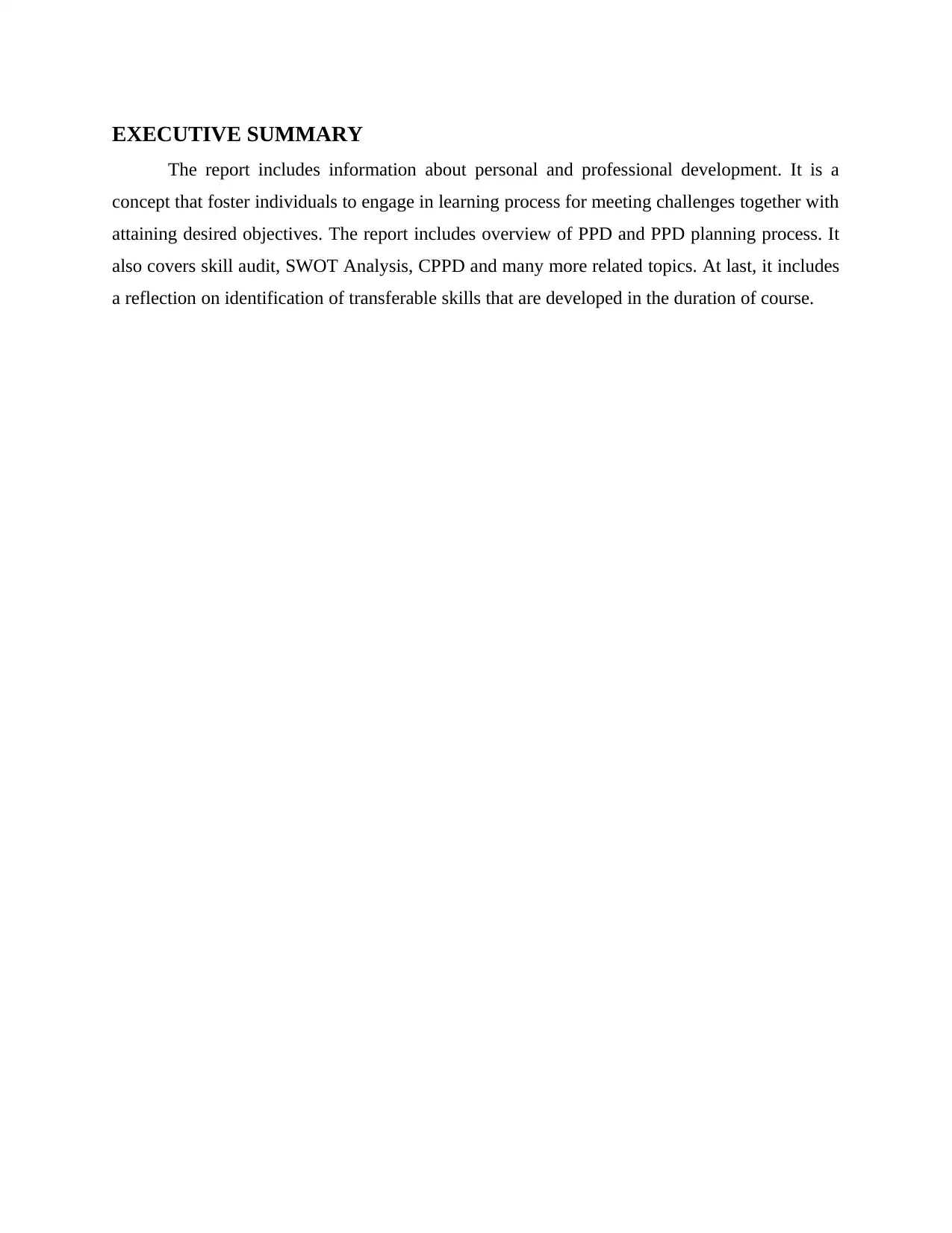
EXECUTIVE SUMMARY
The report includes information about personal and professional development. It is a
concept that foster individuals to engage in learning process for meeting challenges together with
attaining desired objectives. The report includes overview of PPD and PPD planning process. It
also covers skill audit, SWOT Analysis, CPPD and many more related topics. At last, it includes
a reflection on identification of transferable skills that are developed in the duration of course.
The report includes information about personal and professional development. It is a
concept that foster individuals to engage in learning process for meeting challenges together with
attaining desired objectives. The report includes overview of PPD and PPD planning process. It
also covers skill audit, SWOT Analysis, CPPD and many more related topics. At last, it includes
a reflection on identification of transferable skills that are developed in the duration of course.
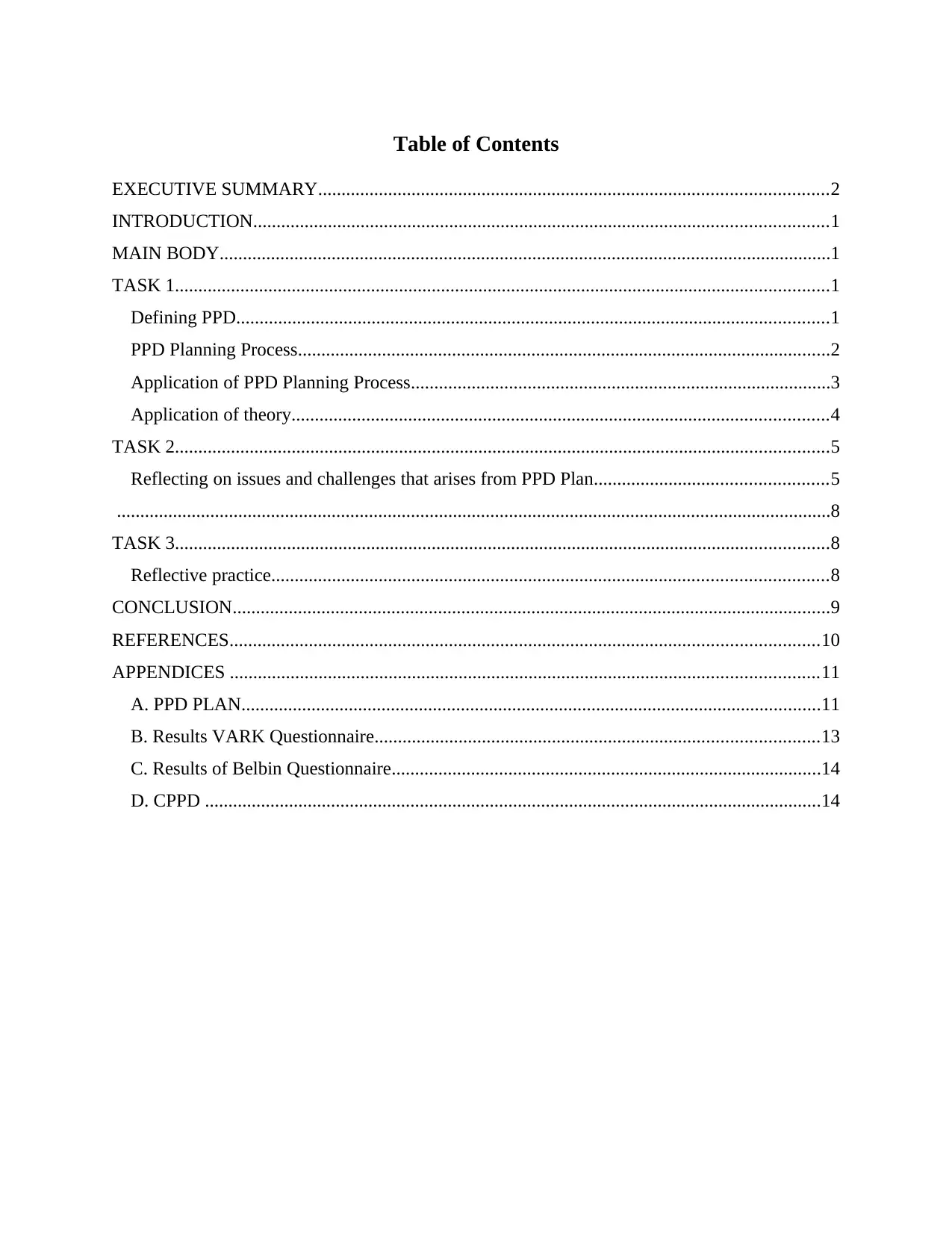
Table of Contents
EXECUTIVE SUMMARY.............................................................................................................2
INTRODUCTION...........................................................................................................................1
MAIN BODY...................................................................................................................................1
TASK 1............................................................................................................................................1
Defining PPD...............................................................................................................................1
PPD Planning Process..................................................................................................................2
Application of PPD Planning Process..........................................................................................3
Application of theory...................................................................................................................4
TASK 2............................................................................................................................................5
Reflecting on issues and challenges that arises from PPD Plan..................................................5
.........................................................................................................................................................8
TASK 3............................................................................................................................................8
Reflective practice.......................................................................................................................8
CONCLUSION................................................................................................................................9
REFERENCES..............................................................................................................................10
APPENDICES ..............................................................................................................................11
A. PPD PLAN............................................................................................................................11
B. Results VARK Questionnaire...............................................................................................13
C. Results of Belbin Questionnaire............................................................................................14
D. CPPD ....................................................................................................................................14
EXECUTIVE SUMMARY.............................................................................................................2
INTRODUCTION...........................................................................................................................1
MAIN BODY...................................................................................................................................1
TASK 1............................................................................................................................................1
Defining PPD...............................................................................................................................1
PPD Planning Process..................................................................................................................2
Application of PPD Planning Process..........................................................................................3
Application of theory...................................................................................................................4
TASK 2............................................................................................................................................5
Reflecting on issues and challenges that arises from PPD Plan..................................................5
.........................................................................................................................................................8
TASK 3............................................................................................................................................8
Reflective practice.......................................................................................................................8
CONCLUSION................................................................................................................................9
REFERENCES..............................................................................................................................10
APPENDICES ..............................................................................................................................11
A. PPD PLAN............................................................................................................................11
B. Results VARK Questionnaire...............................................................................................13
C. Results of Belbin Questionnaire............................................................................................14
D. CPPD ....................................................................................................................................14
⊘ This is a preview!⊘
Do you want full access?
Subscribe today to unlock all pages.

Trusted by 1+ million students worldwide
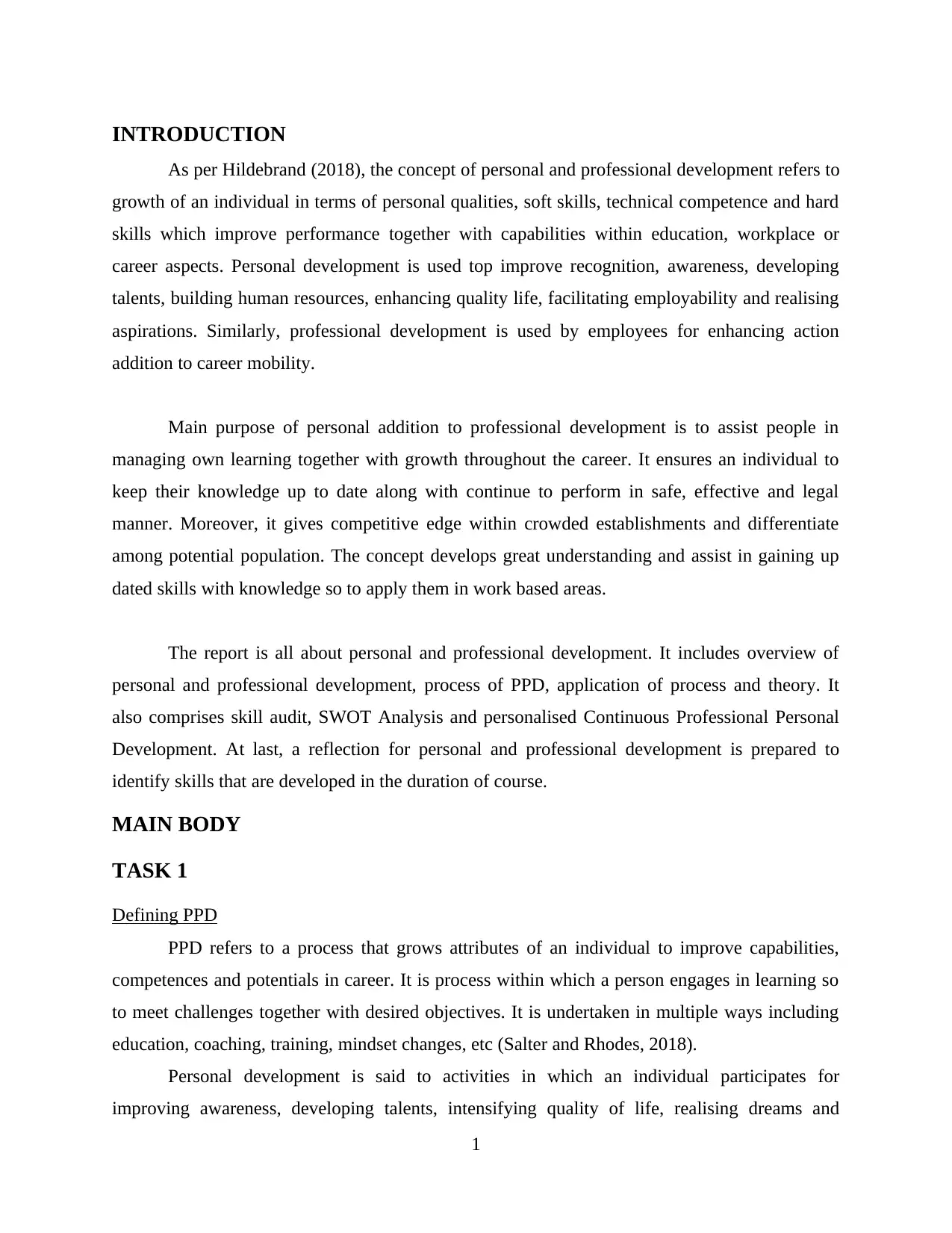
INTRODUCTION
As per Hildebrand (2018), the concept of personal and professional development refers to
growth of an individual in terms of personal qualities, soft skills, technical competence and hard
skills which improve performance together with capabilities within education, workplace or
career aspects. Personal development is used top improve recognition, awareness, developing
talents, building human resources, enhancing quality life, facilitating employability and realising
aspirations. Similarly, professional development is used by employees for enhancing action
addition to career mobility.
Main purpose of personal addition to professional development is to assist people in
managing own learning together with growth throughout the career. It ensures an individual to
keep their knowledge up to date along with continue to perform in safe, effective and legal
manner. Moreover, it gives competitive edge within crowded establishments and differentiate
among potential population. The concept develops great understanding and assist in gaining up
dated skills with knowledge so to apply them in work based areas.
The report is all about personal and professional development. It includes overview of
personal and professional development, process of PPD, application of process and theory. It
also comprises skill audit, SWOT Analysis and personalised Continuous Professional Personal
Development. At last, a reflection for personal and professional development is prepared to
identify skills that are developed in the duration of course.
MAIN BODY
TASK 1
Defining PPD
PPD refers to a process that grows attributes of an individual to improve capabilities,
competences and potentials in career. It is process within which a person engages in learning so
to meet challenges together with desired objectives. It is undertaken in multiple ways including
education, coaching, training, mindset changes, etc (Salter and Rhodes, 2018).
Personal development is said to activities in which an individual participates for
improving awareness, developing talents, intensifying quality of life, realising dreams and
1
As per Hildebrand (2018), the concept of personal and professional development refers to
growth of an individual in terms of personal qualities, soft skills, technical competence and hard
skills which improve performance together with capabilities within education, workplace or
career aspects. Personal development is used top improve recognition, awareness, developing
talents, building human resources, enhancing quality life, facilitating employability and realising
aspirations. Similarly, professional development is used by employees for enhancing action
addition to career mobility.
Main purpose of personal addition to professional development is to assist people in
managing own learning together with growth throughout the career. It ensures an individual to
keep their knowledge up to date along with continue to perform in safe, effective and legal
manner. Moreover, it gives competitive edge within crowded establishments and differentiate
among potential population. The concept develops great understanding and assist in gaining up
dated skills with knowledge so to apply them in work based areas.
The report is all about personal and professional development. It includes overview of
personal and professional development, process of PPD, application of process and theory. It
also comprises skill audit, SWOT Analysis and personalised Continuous Professional Personal
Development. At last, a reflection for personal and professional development is prepared to
identify skills that are developed in the duration of course.
MAIN BODY
TASK 1
Defining PPD
PPD refers to a process that grows attributes of an individual to improve capabilities,
competences and potentials in career. It is process within which a person engages in learning so
to meet challenges together with desired objectives. It is undertaken in multiple ways including
education, coaching, training, mindset changes, etc (Salter and Rhodes, 2018).
Personal development is said to activities in which an individual participates for
improving awareness, developing talents, intensifying quality of life, realising dreams and
1
Paraphrase This Document
Need a fresh take? Get an instant paraphrase of this document with our AI Paraphraser
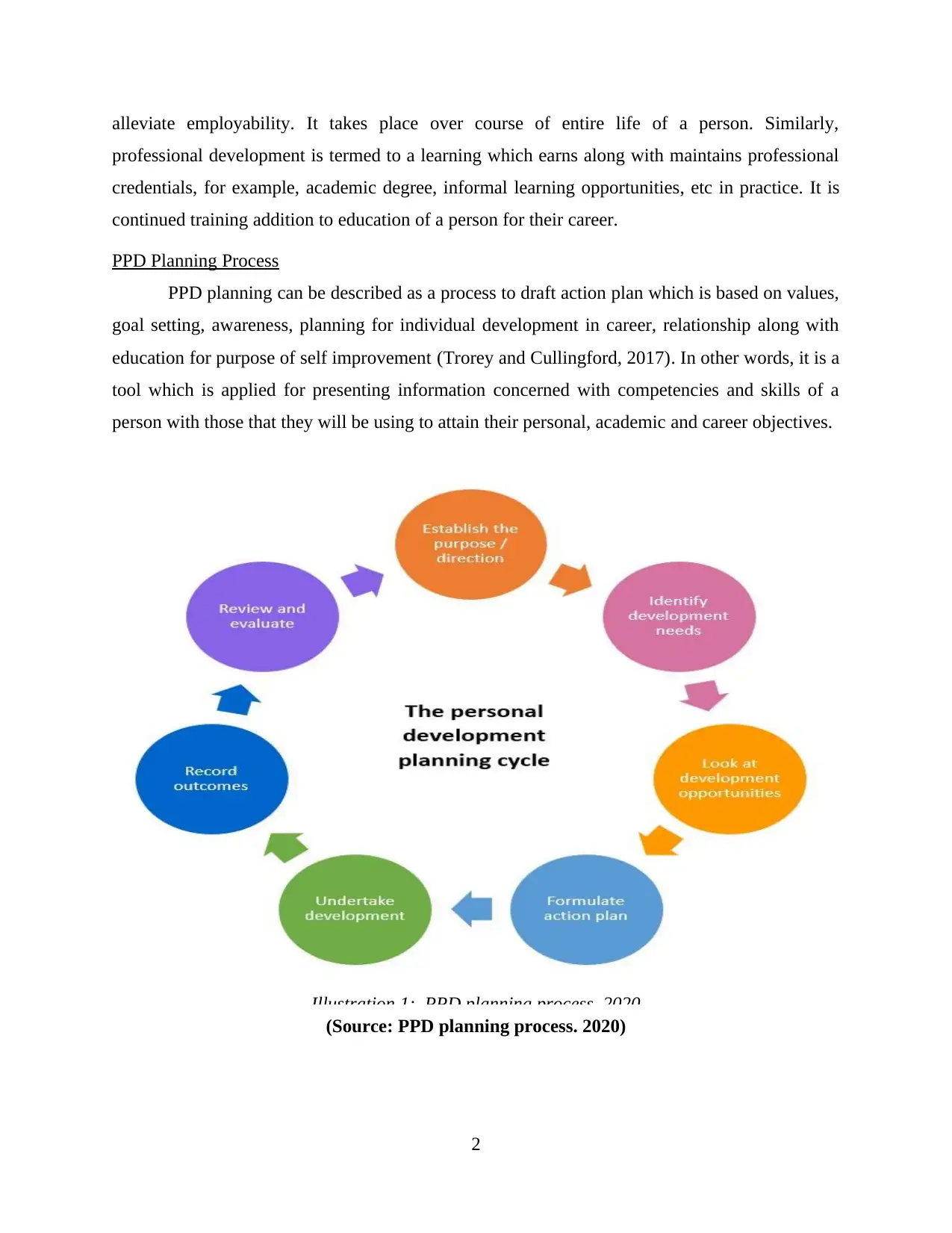
alleviate employability. It takes place over course of entire life of a person. Similarly,
professional development is termed to a learning which earns along with maintains professional
credentials, for example, academic degree, informal learning opportunities, etc in practice. It is
continued training addition to education of a person for their career.
PPD Planning Process
PPD planning can be described as a process to draft action plan which is based on values,
goal setting, awareness, planning for individual development in career, relationship along with
education for purpose of self improvement (Trorey and Cullingford, 2017). In other words, it is a
tool which is applied for presenting information concerned with competencies and skills of a
person with those that they will be using to attain their personal, academic and career objectives.
Illustration 1: PPD planning process. 2020
(Source: PPD planning process. 2020)
2
professional development is termed to a learning which earns along with maintains professional
credentials, for example, academic degree, informal learning opportunities, etc in practice. It is
continued training addition to education of a person for their career.
PPD Planning Process
PPD planning can be described as a process to draft action plan which is based on values,
goal setting, awareness, planning for individual development in career, relationship along with
education for purpose of self improvement (Trorey and Cullingford, 2017). In other words, it is a
tool which is applied for presenting information concerned with competencies and skills of a
person with those that they will be using to attain their personal, academic and career objectives.
Illustration 1: PPD planning process. 2020
(Source: PPD planning process. 2020)
2
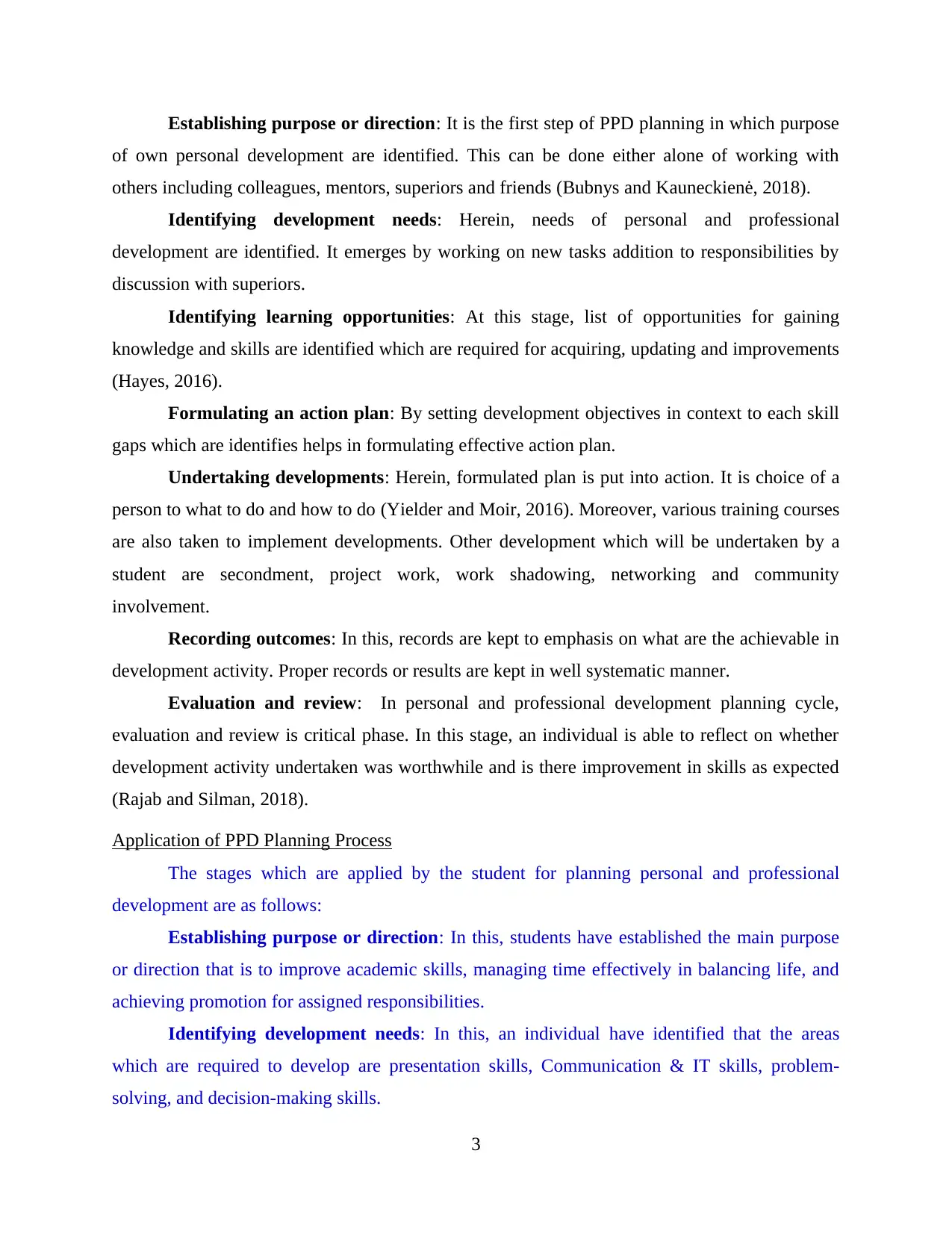
Establishing purpose or direction: It is the first step of PPD planning in which purpose
of own personal development are identified. This can be done either alone of working with
others including colleagues, mentors, superiors and friends (Bubnys and Kauneckienė, 2018).
Identifying development needs: Herein, needs of personal and professional
development are identified. It emerges by working on new tasks addition to responsibilities by
discussion with superiors.
Identifying learning opportunities: At this stage, list of opportunities for gaining
knowledge and skills are identified which are required for acquiring, updating and improvements
(Hayes, 2016).
Formulating an action plan: By setting development objectives in context to each skill
gaps which are identifies helps in formulating effective action plan.
Undertaking developments: Herein, formulated plan is put into action. It is choice of a
person to what to do and how to do (Yielder and Moir, 2016). Moreover, various training courses
are also taken to implement developments. Other development which will be undertaken by a
student are secondment, project work, work shadowing, networking and community
involvement.
Recording outcomes: In this, records are kept to emphasis on what are the achievable in
development activity. Proper records or results are kept in well systematic manner.
Evaluation and review: In personal and professional development planning cycle,
evaluation and review is critical phase. In this stage, an individual is able to reflect on whether
development activity undertaken was worthwhile and is there improvement in skills as expected
(Rajab and Silman, 2018).
Application of PPD Planning Process
The stages which are applied by the student for planning personal and professional
development are as follows:
Establishing purpose or direction: In this, students have established the main purpose
or direction that is to improve academic skills, managing time effectively in balancing life, and
achieving promotion for assigned responsibilities.
Identifying development needs: In this, an individual have identified that the areas
which are required to develop are presentation skills, Communication & IT skills, problem-
solving, and decision-making skills.
3
of own personal development are identified. This can be done either alone of working with
others including colleagues, mentors, superiors and friends (Bubnys and Kauneckienė, 2018).
Identifying development needs: Herein, needs of personal and professional
development are identified. It emerges by working on new tasks addition to responsibilities by
discussion with superiors.
Identifying learning opportunities: At this stage, list of opportunities for gaining
knowledge and skills are identified which are required for acquiring, updating and improvements
(Hayes, 2016).
Formulating an action plan: By setting development objectives in context to each skill
gaps which are identifies helps in formulating effective action plan.
Undertaking developments: Herein, formulated plan is put into action. It is choice of a
person to what to do and how to do (Yielder and Moir, 2016). Moreover, various training courses
are also taken to implement developments. Other development which will be undertaken by a
student are secondment, project work, work shadowing, networking and community
involvement.
Recording outcomes: In this, records are kept to emphasis on what are the achievable in
development activity. Proper records or results are kept in well systematic manner.
Evaluation and review: In personal and professional development planning cycle,
evaluation and review is critical phase. In this stage, an individual is able to reflect on whether
development activity undertaken was worthwhile and is there improvement in skills as expected
(Rajab and Silman, 2018).
Application of PPD Planning Process
The stages which are applied by the student for planning personal and professional
development are as follows:
Establishing purpose or direction: In this, students have established the main purpose
or direction that is to improve academic skills, managing time effectively in balancing life, and
achieving promotion for assigned responsibilities.
Identifying development needs: In this, an individual have identified that the areas
which are required to develop are presentation skills, Communication & IT skills, problem-
solving, and decision-making skills.
3
⊘ This is a preview!⊘
Do you want full access?
Subscribe today to unlock all pages.

Trusted by 1+ million students worldwide
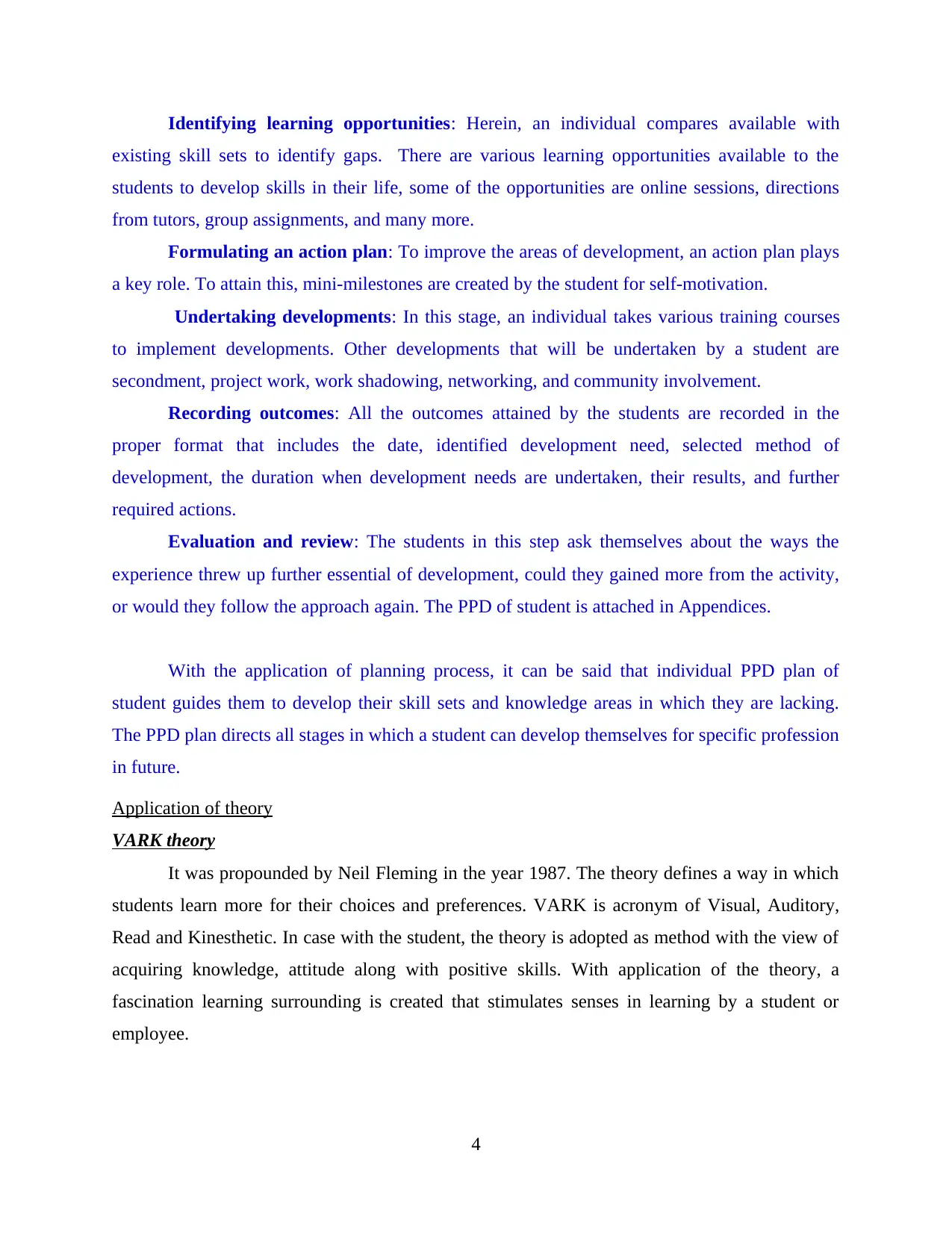
Identifying learning opportunities: Herein, an individual compares available with
existing skill sets to identify gaps. There are various learning opportunities available to the
students to develop skills in their life, some of the opportunities are online sessions, directions
from tutors, group assignments, and many more.
Formulating an action plan: To improve the areas of development, an action plan plays
a key role. To attain this, mini-milestones are created by the student for self-motivation.
Undertaking developments: In this stage, an individual takes various training courses
to implement developments. Other developments that will be undertaken by a student are
secondment, project work, work shadowing, networking, and community involvement.
Recording outcomes: All the outcomes attained by the students are recorded in the
proper format that includes the date, identified development need, selected method of
development, the duration when development needs are undertaken, their results, and further
required actions.
Evaluation and review: The students in this step ask themselves about the ways the
experience threw up further essential of development, could they gained more from the activity,
or would they follow the approach again. The PPD of student is attached in Appendices.
With the application of planning process, it can be said that individual PPD plan of
student guides them to develop their skill sets and knowledge areas in which they are lacking.
The PPD plan directs all stages in which a student can develop themselves for specific profession
in future.
Application of theory
VARK theory
It was propounded by Neil Fleming in the year 1987. The theory defines a way in which
students learn more for their choices and preferences. VARK is acronym of Visual, Auditory,
Read and Kinesthetic. In case with the student, the theory is adopted as method with the view of
acquiring knowledge, attitude along with positive skills. With application of the theory, a
fascination learning surrounding is created that stimulates senses in learning by a student or
employee.
4
existing skill sets to identify gaps. There are various learning opportunities available to the
students to develop skills in their life, some of the opportunities are online sessions, directions
from tutors, group assignments, and many more.
Formulating an action plan: To improve the areas of development, an action plan plays
a key role. To attain this, mini-milestones are created by the student for self-motivation.
Undertaking developments: In this stage, an individual takes various training courses
to implement developments. Other developments that will be undertaken by a student are
secondment, project work, work shadowing, networking, and community involvement.
Recording outcomes: All the outcomes attained by the students are recorded in the
proper format that includes the date, identified development need, selected method of
development, the duration when development needs are undertaken, their results, and further
required actions.
Evaluation and review: The students in this step ask themselves about the ways the
experience threw up further essential of development, could they gained more from the activity,
or would they follow the approach again. The PPD of student is attached in Appendices.
With the application of planning process, it can be said that individual PPD plan of
student guides them to develop their skill sets and knowledge areas in which they are lacking.
The PPD plan directs all stages in which a student can develop themselves for specific profession
in future.
Application of theory
VARK theory
It was propounded by Neil Fleming in the year 1987. The theory defines a way in which
students learn more for their choices and preferences. VARK is acronym of Visual, Auditory,
Read and Kinesthetic. In case with the student, the theory is adopted as method with the view of
acquiring knowledge, attitude along with positive skills. With application of the theory, a
fascination learning surrounding is created that stimulates senses in learning by a student or
employee.
4
Paraphrase This Document
Need a fresh take? Get an instant paraphrase of this document with our AI Paraphraser
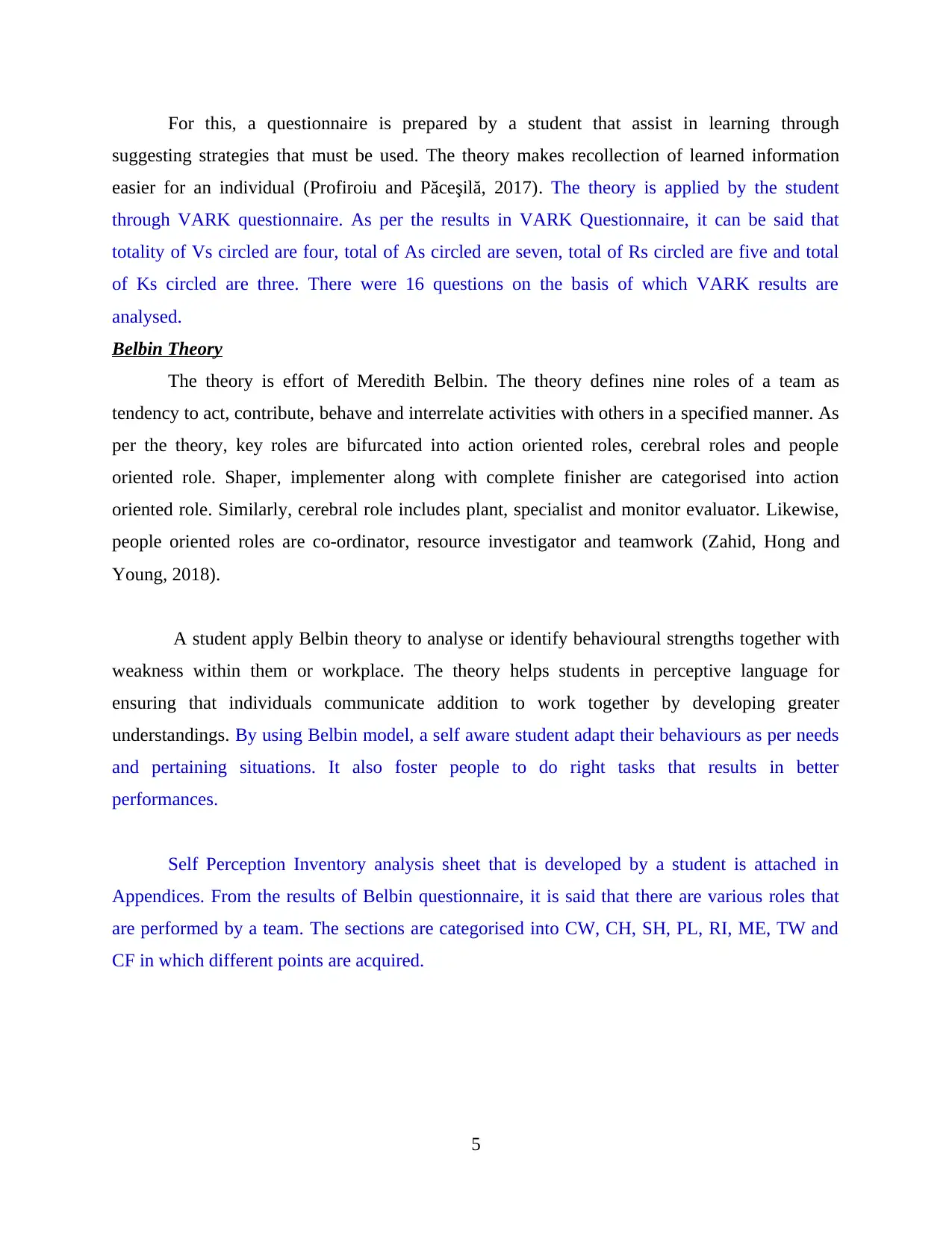
For this, a questionnaire is prepared by a student that assist in learning through
suggesting strategies that must be used. The theory makes recollection of learned information
easier for an individual (Profiroiu and Păceşilă, 2017). The theory is applied by the student
through VARK questionnaire. As per the results in VARK Questionnaire, it can be said that
totality of Vs circled are four, total of As circled are seven, total of Rs circled are five and total
of Ks circled are three. There were 16 questions on the basis of which VARK results are
analysed.
Belbin Theory
The theory is effort of Meredith Belbin. The theory defines nine roles of a team as
tendency to act, contribute, behave and interrelate activities with others in a specified manner. As
per the theory, key roles are bifurcated into action oriented roles, cerebral roles and people
oriented role. Shaper, implementer along with complete finisher are categorised into action
oriented role. Similarly, cerebral role includes plant, specialist and monitor evaluator. Likewise,
people oriented roles are co-ordinator, resource investigator and teamwork (Zahid, Hong and
Young, 2018).
A student apply Belbin theory to analyse or identify behavioural strengths together with
weakness within them or workplace. The theory helps students in perceptive language for
ensuring that individuals communicate addition to work together by developing greater
understandings. By using Belbin model, a self aware student adapt their behaviours as per needs
and pertaining situations. It also foster people to do right tasks that results in better
performances.
Self Perception Inventory analysis sheet that is developed by a student is attached in
Appendices. From the results of Belbin questionnaire, it is said that there are various roles that
are performed by a team. The sections are categorised into CW, CH, SH, PL, RI, ME, TW and
CF in which different points are acquired.
5
suggesting strategies that must be used. The theory makes recollection of learned information
easier for an individual (Profiroiu and Păceşilă, 2017). The theory is applied by the student
through VARK questionnaire. As per the results in VARK Questionnaire, it can be said that
totality of Vs circled are four, total of As circled are seven, total of Rs circled are five and total
of Ks circled are three. There were 16 questions on the basis of which VARK results are
analysed.
Belbin Theory
The theory is effort of Meredith Belbin. The theory defines nine roles of a team as
tendency to act, contribute, behave and interrelate activities with others in a specified manner. As
per the theory, key roles are bifurcated into action oriented roles, cerebral roles and people
oriented role. Shaper, implementer along with complete finisher are categorised into action
oriented role. Similarly, cerebral role includes plant, specialist and monitor evaluator. Likewise,
people oriented roles are co-ordinator, resource investigator and teamwork (Zahid, Hong and
Young, 2018).
A student apply Belbin theory to analyse or identify behavioural strengths together with
weakness within them or workplace. The theory helps students in perceptive language for
ensuring that individuals communicate addition to work together by developing greater
understandings. By using Belbin model, a self aware student adapt their behaviours as per needs
and pertaining situations. It also foster people to do right tasks that results in better
performances.
Self Perception Inventory analysis sheet that is developed by a student is attached in
Appendices. From the results of Belbin questionnaire, it is said that there are various roles that
are performed by a team. The sections are categorised into CW, CH, SH, PL, RI, ME, TW and
CF in which different points are acquired.
5
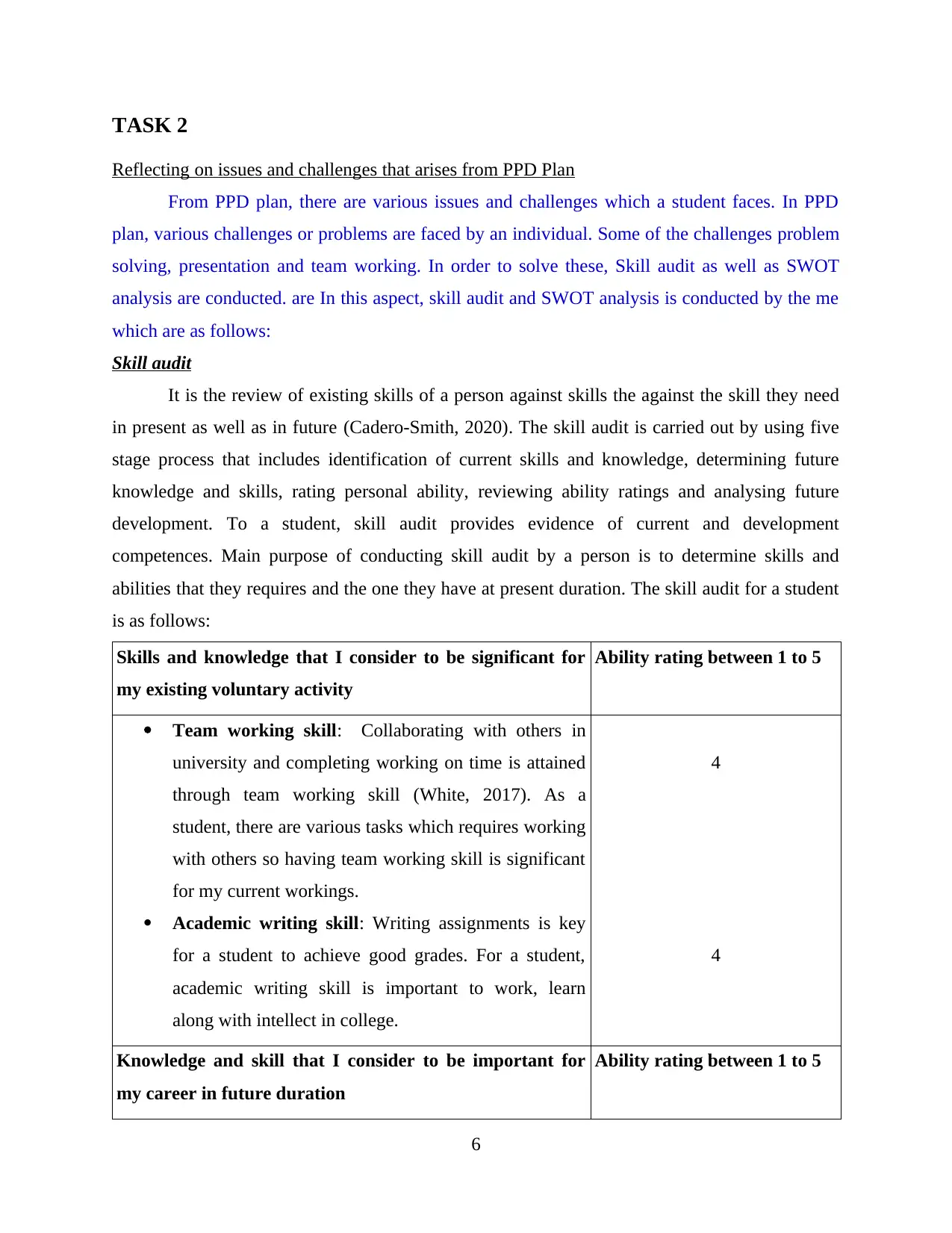
TASK 2
Reflecting on issues and challenges that arises from PPD Plan
From PPD plan, there are various issues and challenges which a student faces. In PPD
plan, various challenges or problems are faced by an individual. Some of the challenges problem
solving, presentation and team working. In order to solve these, Skill audit as well as SWOT
analysis are conducted. are In this aspect, skill audit and SWOT analysis is conducted by the me
which are as follows:
Skill audit
It is the review of existing skills of a person against skills the against the skill they need
in present as well as in future (Cadero-Smith, 2020). The skill audit is carried out by using five
stage process that includes identification of current skills and knowledge, determining future
knowledge and skills, rating personal ability, reviewing ability ratings and analysing future
development. To a student, skill audit provides evidence of current and development
competences. Main purpose of conducting skill audit by a person is to determine skills and
abilities that they requires and the one they have at present duration. The skill audit for a student
is as follows:
Skills and knowledge that I consider to be significant for
my existing voluntary activity
Ability rating between 1 to 5
Team working skill: Collaborating with others in
university and completing working on time is attained
through team working skill (White, 2017). As a
student, there are various tasks which requires working
with others so having team working skill is significant
for my current workings.
Academic writing skill: Writing assignments is key
for a student to achieve good grades. For a student,
academic writing skill is important to work, learn
along with intellect in college.
4
4
Knowledge and skill that I consider to be important for
my career in future duration
Ability rating between 1 to 5
6
Reflecting on issues and challenges that arises from PPD Plan
From PPD plan, there are various issues and challenges which a student faces. In PPD
plan, various challenges or problems are faced by an individual. Some of the challenges problem
solving, presentation and team working. In order to solve these, Skill audit as well as SWOT
analysis are conducted. are In this aspect, skill audit and SWOT analysis is conducted by the me
which are as follows:
Skill audit
It is the review of existing skills of a person against skills the against the skill they need
in present as well as in future (Cadero-Smith, 2020). The skill audit is carried out by using five
stage process that includes identification of current skills and knowledge, determining future
knowledge and skills, rating personal ability, reviewing ability ratings and analysing future
development. To a student, skill audit provides evidence of current and development
competences. Main purpose of conducting skill audit by a person is to determine skills and
abilities that they requires and the one they have at present duration. The skill audit for a student
is as follows:
Skills and knowledge that I consider to be significant for
my existing voluntary activity
Ability rating between 1 to 5
Team working skill: Collaborating with others in
university and completing working on time is attained
through team working skill (White, 2017). As a
student, there are various tasks which requires working
with others so having team working skill is significant
for my current workings.
Academic writing skill: Writing assignments is key
for a student to achieve good grades. For a student,
academic writing skill is important to work, learn
along with intellect in college.
4
4
Knowledge and skill that I consider to be important for
my career in future duration
Ability rating between 1 to 5
6
⊘ This is a preview!⊘
Do you want full access?
Subscribe today to unlock all pages.

Trusted by 1+ million students worldwide
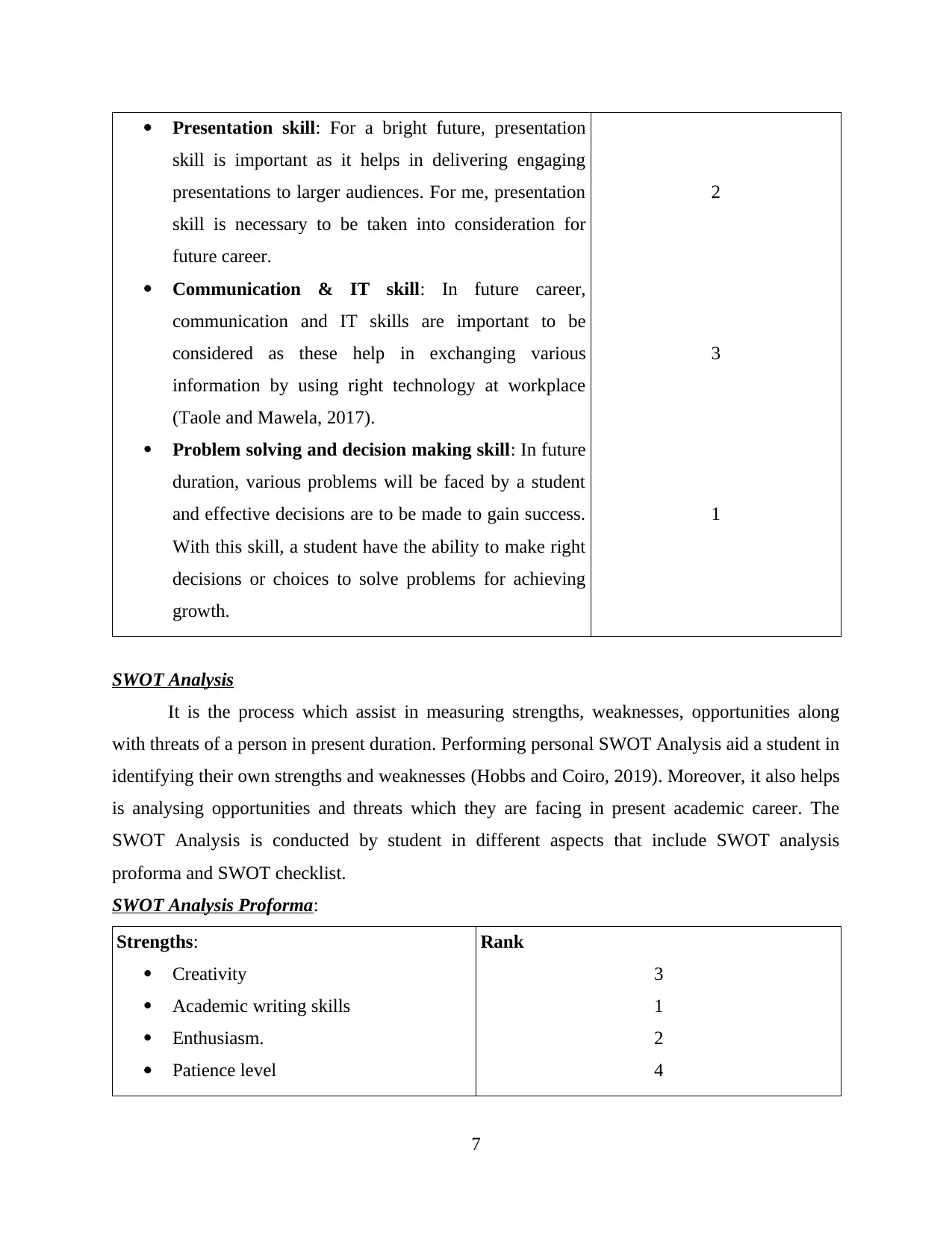
Presentation skill: For a bright future, presentation
skill is important as it helps in delivering engaging
presentations to larger audiences. For me, presentation
skill is necessary to be taken into consideration for
future career.
Communication & IT skill: In future career,
communication and IT skills are important to be
considered as these help in exchanging various
information by using right technology at workplace
(Taole and Mawela, 2017).
Problem solving and decision making skill: In future
duration, various problems will be faced by a student
and effective decisions are to be made to gain success.
With this skill, a student have the ability to make right
decisions or choices to solve problems for achieving
growth.
2
3
1
SWOT Analysis
It is the process which assist in measuring strengths, weaknesses, opportunities along
with threats of a person in present duration. Performing personal SWOT Analysis aid a student in
identifying their own strengths and weaknesses (Hobbs and Coiro, 2019). Moreover, it also helps
is analysing opportunities and threats which they are facing in present academic career. The
SWOT Analysis is conducted by student in different aspects that include SWOT analysis
proforma and SWOT checklist.
SWOT Analysis Proforma:
Strengths:
Creativity
Academic writing skills
Enthusiasm.
Patience level
Rank
3
1
2
4
7
skill is important as it helps in delivering engaging
presentations to larger audiences. For me, presentation
skill is necessary to be taken into consideration for
future career.
Communication & IT skill: In future career,
communication and IT skills are important to be
considered as these help in exchanging various
information by using right technology at workplace
(Taole and Mawela, 2017).
Problem solving and decision making skill: In future
duration, various problems will be faced by a student
and effective decisions are to be made to gain success.
With this skill, a student have the ability to make right
decisions or choices to solve problems for achieving
growth.
2
3
1
SWOT Analysis
It is the process which assist in measuring strengths, weaknesses, opportunities along
with threats of a person in present duration. Performing personal SWOT Analysis aid a student in
identifying their own strengths and weaknesses (Hobbs and Coiro, 2019). Moreover, it also helps
is analysing opportunities and threats which they are facing in present academic career. The
SWOT Analysis is conducted by student in different aspects that include SWOT analysis
proforma and SWOT checklist.
SWOT Analysis Proforma:
Strengths:
Creativity
Academic writing skills
Enthusiasm.
Patience level
Rank
3
1
2
4
7
Paraphrase This Document
Need a fresh take? Get an instant paraphrase of this document with our AI Paraphraser
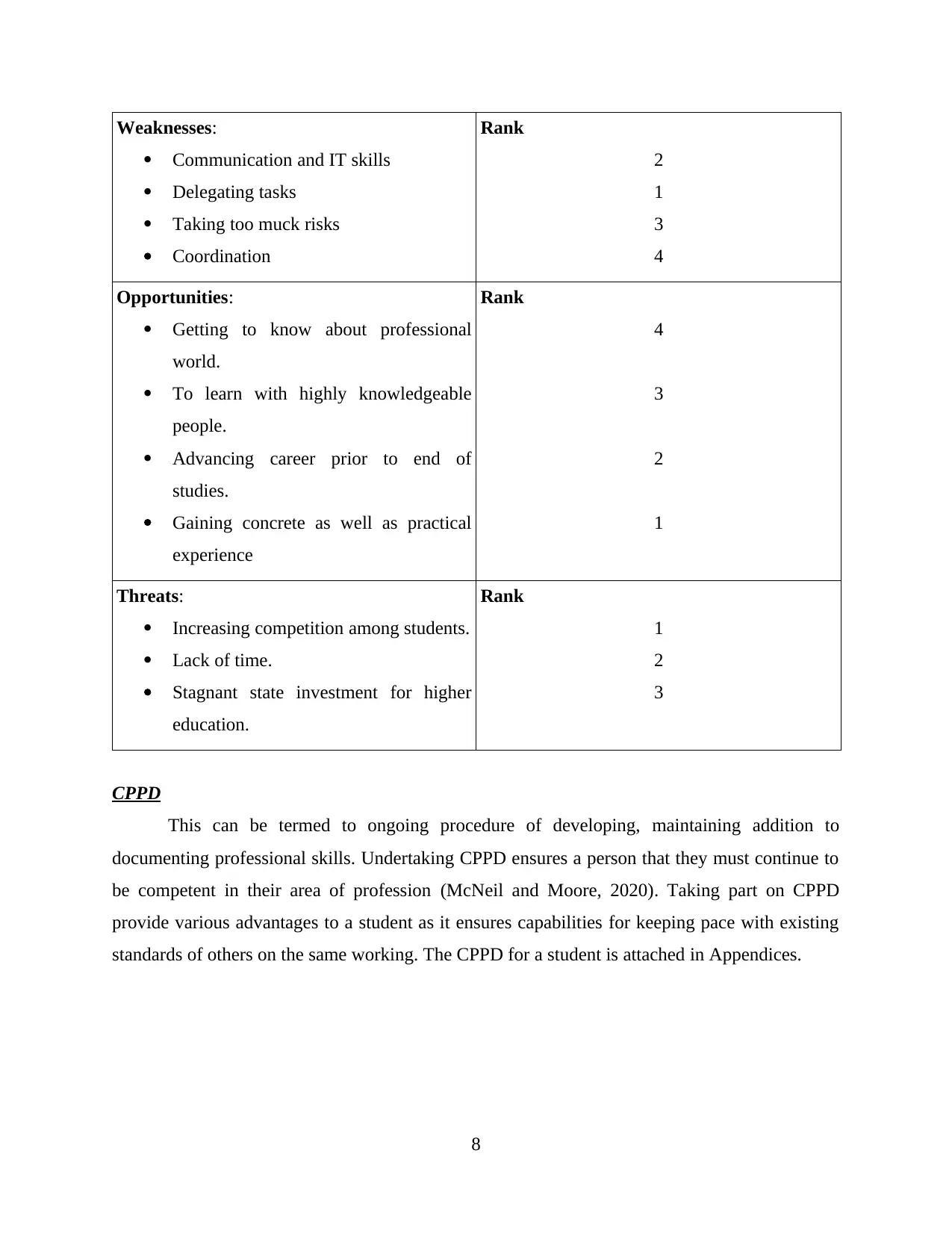
Weaknesses:
Communication and IT skills
Delegating tasks
Taking too muck risks
Coordination
Rank
2
1
3
4
Opportunities:
Getting to know about professional
world.
To learn with highly knowledgeable
people.
Advancing career prior to end of
studies.
Gaining concrete as well as practical
experience
Rank
4
3
2
1
Threats:
Increasing competition among students.
Lack of time.
Stagnant state investment for higher
education.
Rank
1
2
3
CPPD
This can be termed to ongoing procedure of developing, maintaining addition to
documenting professional skills. Undertaking CPPD ensures a person that they must continue to
be competent in their area of profession (McNeil and Moore, 2020). Taking part on CPPD
provide various advantages to a student as it ensures capabilities for keeping pace with existing
standards of others on the same working. The CPPD for a student is attached in Appendices.
8
Communication and IT skills
Delegating tasks
Taking too muck risks
Coordination
Rank
2
1
3
4
Opportunities:
Getting to know about professional
world.
To learn with highly knowledgeable
people.
Advancing career prior to end of
studies.
Gaining concrete as well as practical
experience
Rank
4
3
2
1
Threats:
Increasing competition among students.
Lack of time.
Stagnant state investment for higher
education.
Rank
1
2
3
CPPD
This can be termed to ongoing procedure of developing, maintaining addition to
documenting professional skills. Undertaking CPPD ensures a person that they must continue to
be competent in their area of profession (McNeil and Moore, 2020). Taking part on CPPD
provide various advantages to a student as it ensures capabilities for keeping pace with existing
standards of others on the same working. The CPPD for a student is attached in Appendices.
8
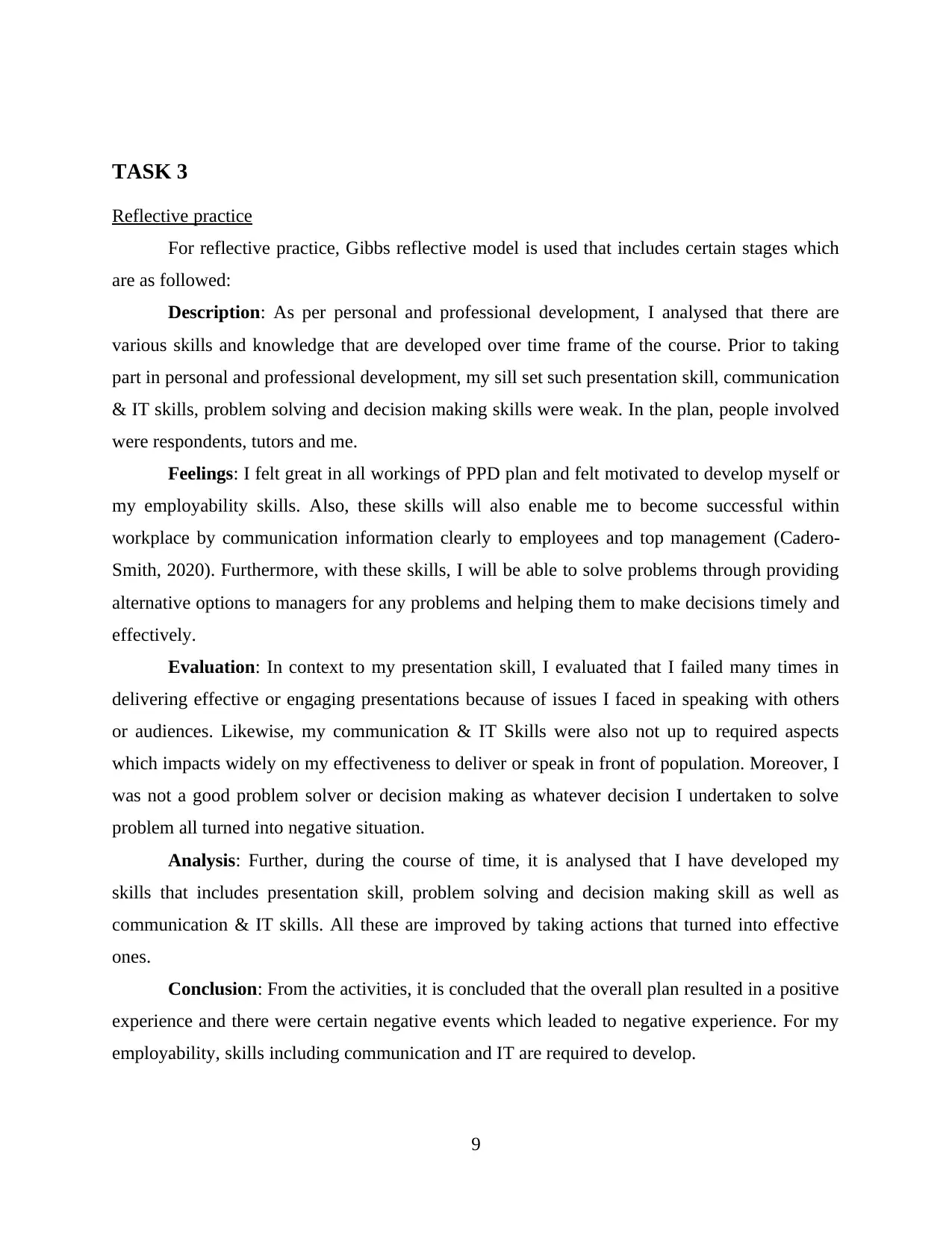
TASK 3
Reflective practice
For reflective practice, Gibbs reflective model is used that includes certain stages which
are as followed:
Description: As per personal and professional development, I analysed that there are
various skills and knowledge that are developed over time frame of the course. Prior to taking
part in personal and professional development, my sill set such presentation skill, communication
& IT skills, problem solving and decision making skills were weak. In the plan, people involved
were respondents, tutors and me.
Feelings: I felt great in all workings of PPD plan and felt motivated to develop myself or
my employability skills. Also, these skills will also enable me to become successful within
workplace by communication information clearly to employees and top management (Cadero-
Smith, 2020). Furthermore, with these skills, I will be able to solve problems through providing
alternative options to managers for any problems and helping them to make decisions timely and
effectively.
Evaluation: In context to my presentation skill, I evaluated that I failed many times in
delivering effective or engaging presentations because of issues I faced in speaking with others
or audiences. Likewise, my communication & IT Skills were also not up to required aspects
which impacts widely on my effectiveness to deliver or speak in front of population. Moreover, I
was not a good problem solver or decision making as whatever decision I undertaken to solve
problem all turned into negative situation.
Analysis: Further, during the course of time, it is analysed that I have developed my
skills that includes presentation skill, problem solving and decision making skill as well as
communication & IT skills. All these are improved by taking actions that turned into effective
ones.
Conclusion: From the activities, it is concluded that the overall plan resulted in a positive
experience and there were certain negative events which leaded to negative experience. For my
employability, skills including communication and IT are required to develop.
9
Reflective practice
For reflective practice, Gibbs reflective model is used that includes certain stages which
are as followed:
Description: As per personal and professional development, I analysed that there are
various skills and knowledge that are developed over time frame of the course. Prior to taking
part in personal and professional development, my sill set such presentation skill, communication
& IT skills, problem solving and decision making skills were weak. In the plan, people involved
were respondents, tutors and me.
Feelings: I felt great in all workings of PPD plan and felt motivated to develop myself or
my employability skills. Also, these skills will also enable me to become successful within
workplace by communication information clearly to employees and top management (Cadero-
Smith, 2020). Furthermore, with these skills, I will be able to solve problems through providing
alternative options to managers for any problems and helping them to make decisions timely and
effectively.
Evaluation: In context to my presentation skill, I evaluated that I failed many times in
delivering effective or engaging presentations because of issues I faced in speaking with others
or audiences. Likewise, my communication & IT Skills were also not up to required aspects
which impacts widely on my effectiveness to deliver or speak in front of population. Moreover, I
was not a good problem solver or decision making as whatever decision I undertaken to solve
problem all turned into negative situation.
Analysis: Further, during the course of time, it is analysed that I have developed my
skills that includes presentation skill, problem solving and decision making skill as well as
communication & IT skills. All these are improved by taking actions that turned into effective
ones.
Conclusion: From the activities, it is concluded that the overall plan resulted in a positive
experience and there were certain negative events which leaded to negative experience. For my
employability, skills including communication and IT are required to develop.
9
⊘ This is a preview!⊘
Do you want full access?
Subscribe today to unlock all pages.

Trusted by 1+ million students worldwide
1 out of 20
Related Documents
Your All-in-One AI-Powered Toolkit for Academic Success.
+13062052269
info@desklib.com
Available 24*7 on WhatsApp / Email
![[object Object]](/_next/static/media/star-bottom.7253800d.svg)
Unlock your academic potential
Copyright © 2020–2025 A2Z Services. All Rights Reserved. Developed and managed by ZUCOL.





